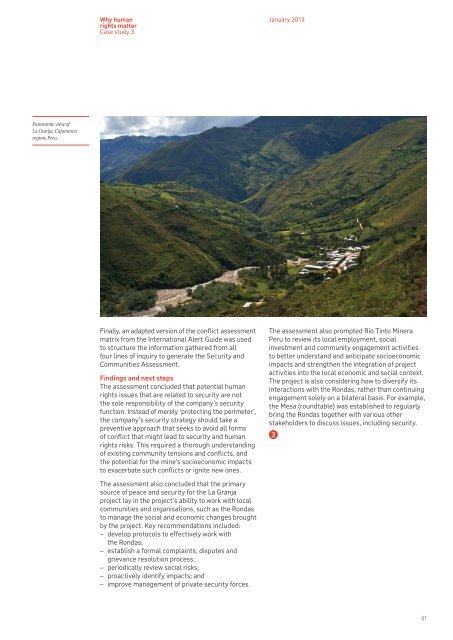Why human rights matter - Rio Tinto
Why human rights matter - Rio Tinto
Why human rights matter - Rio Tinto
You also want an ePaper? Increase the reach of your titles
YUMPU automatically turns print PDFs into web optimized ePapers that Google loves.
<strong>Why</strong> <strong>human</strong><br />
<strong>rights</strong> <strong>matter</strong><br />
Case study 3<br />
January 2013<br />
Panoramic view of<br />
La Granja, Cajamarca<br />
region, Peru.<br />
Finally, an adapted version of the conflict assessment<br />
matrix from the International Alert Guide was used<br />
to structure the information gathered from all<br />
four lines of inquiry to generate the Security and<br />
Communities Assessment.<br />
Findings and next steps<br />
The assessment concluded that potential <strong>human</strong><br />
<strong>rights</strong> issues that are related to security are not<br />
the sole responsibility of the company’s security<br />
function. Instead of merely ‘protecting the perimeter’,<br />
the company’s security strategy should take a<br />
preventive approach that seeks to avoid all forms<br />
of conflict that might lead to security and <strong>human</strong><br />
<strong>rights</strong> risks. This required a thorough understanding<br />
of existing community tensions and conflicts, and<br />
the potential for the mine’s socioeconomic impacts<br />
to exacerbate such conflicts or ignite new ones.<br />
The assessment also prompted <strong>Rio</strong> <strong>Tinto</strong> Minera<br />
Peru to review its local employment, social<br />
investment and community engagement activities<br />
to better understand and anticipate socioeconomic<br />
impacts and strengthen the integration of project<br />
activities into the local economic and social context.<br />
The project is also considering how to diversify its<br />
interactions with the Rondas, rather than continuing<br />
engagement solely on a bilateral basis. For example,<br />
the Mesa (roundtable) was established to regularly<br />
bring the Rondas together with various other<br />
stakeholders to discuss issues, including security.<br />
3<br />
The assessment also concluded that the primary<br />
source of peace and security for the La Granja<br />
project lay in the project’s ability to work with local<br />
communities and organisations, such as the Rondas<br />
to manage the social and economic changes brought<br />
by the project. Key recommendations included:<br />
– develop protocols to effectively work with<br />
the Rondas;<br />
– establish a formal complaints, disputes and<br />
grievance resolution process;<br />
– periodically review social risks;<br />
– proactively identify impacts; and<br />
– improve management of private security forces.<br />
41
















![[PDF] Community Development Toolkit - CommDev](https://img.yumpu.com/48616495/1/184x260/pdf-community-development-toolkit-commdev.jpg?quality=85)
